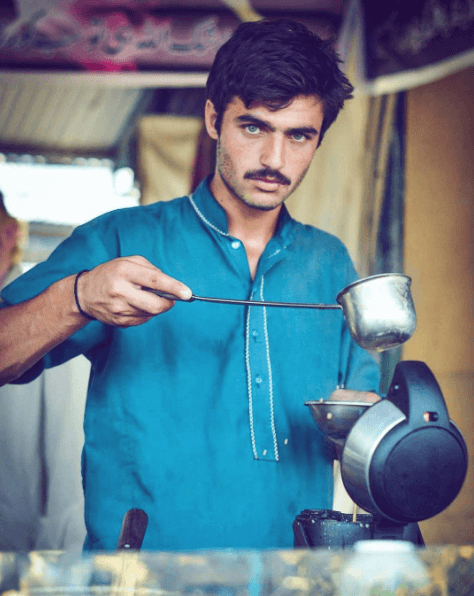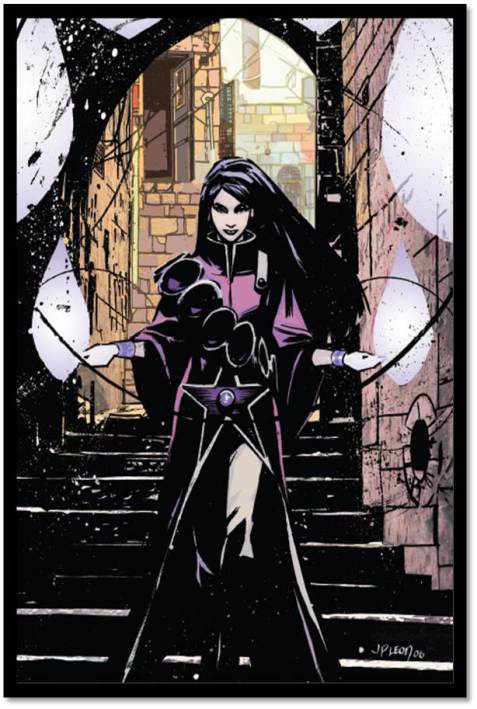Many people have seen the photograph of 18-year-old Arshad Khan, the Afghan Pashtun* worker at an Islamabad tea stand whose photo has gone viral globally. When the image of this tea vendor who had neither a name nor a story attached to him appeared on my social media timeline, I immediately felt deeply uncomfortable. This was yet another image that fetishized Pashtuns and fed into our dehumanization by constructing narratives that uphold violent structures against Pashtuns.
A quick google search of Pashtuns, one of the largest ethnic groups in Afghanistan and with a significant presence in Pakistan, returns hundreds of images similar to that of Khan— individuals with light skin and light eyes who are almost always staring mournfully or in terror into the camera with wide, wounded eyes.
Such images dehumanize Pashtuns by framing their traumatized expressions as exotic, yet terrifying all at the same time. Part of the fascination with Pashtun faces is a fascination with faces that tell stories of raw pain, loss and trauma. Such images reduce the struggle of Pashtun people down to nameless images and the trauma captured on Pashtun faces is seen as an experience for viewers. It is voyeuristic.
The fetishization of Pashtuns is nothing new; it predates European and American imperialism in the subcontinent. And although Pashtuns have a complex history in terms of migration patterns, and how they identify themselves, people have treated Pashtuns as a homogenous body to be fetishized and, in the context of the War on Terror, exploited and demonized. When we fawn over photos like that of Khan, make racist statements on his class status in society, erase his name and identity from the photo, and make remarks devoid of any critical thought on the conditions Afghan and Pakistani Pashtuns are facing in this current political moment, we are reinforcing this centuries-old exploitation.
Pashtuns in Afghanistan and Pakistan have paid a heavy price in the War on Terror. Both the U.S. and Pakistan have jumped on the deeply internalized narrative of the Pashtuns as exotic, barbaric, violent, and inherently patriarchal people to further create negative cultural constructs of this group. For example, movies, television shows, books, journalism and social media now routinely portray Pashtuns as terrorists, the Taliban, and as security threats. Simultaneously, Pashtuns are romanticized as warriors who must serve in the military, unintelligent but loyal cheap laborers meant to be exploited. There is also the narrative that Pashtuns are naturally predisposed to war and therefore less traumatized by it than other groups; this is used to dismissively explain why Afghanistan has been in a state of tumult for nearly 40 years now. And because violence and anarchy is simply part of who Pashtuns are, we can use them as tools in our wars. Further, Pashtuns are seen as burdensome refugees/victims leeching on the Pakistani state and expecting handouts who are seen through the lens of criminals and terrorists. Of course there is no room in this construct to examine the role of the host country in facilitating the social conditions that result in mass internal and external displacement.
Sharing and “liking” Khan’s photo and remarking on his features meanwhile conveniently being fully complicit in the systems that dehumanize Pashtuns is the problem. It is hypocritical to fully support the Pakistani state’s demand of removing 3 million Afghan refugees, many of whom are Afghan Pashtuns to leave the country, while standing by and idolizing the nameless chaiwala to detract away from the social conditions that have produced millions of Khans. It means overlooking the violence Pashtuns have faced in Afghanistan and Pakistan as victims of extrajudicial killings, military campaigns, incarceration, surveillance, disappearances, and terrorist attacks. It means overlooking the 70,000 people have been murdered in Khyber Pakhtunkhwa and over 1 million who have been displaced in FATA, both regions controlled by the Pakistani state that have faced the brunt of the Pakistani-US military campaigns in the War on Terror. Overall, the US-led War on Terror, has resulted in the deaths of at least 220,000 Afghans and 80,000 people in Pakistan. Many of whom are Pashtuns.
In order to justify violence against Pashtuns in this instance, there are narratives that the Pakistani state, alongside the US military have continued to support in order to destroy any empathy and solidarity for the Pashtun people.
For example, the US military, specifically the Army commissioned anthropologists to study Pashtuns and Pashtunwali through the Human Terrain Teams, where social scientists with zero expertise and knowledge on Pashtun communities accompanied the US military to study Pashtuns for the end purposes of fighting a more successful counterinsurgency against local communities under a foreign occupying force.
One study in particular on the sexuality of Pashtuns, commissioned by the US military, observed that Pashtuns are inherently prone to queerness and as a consequence boys are sexually abused by older men, who then turn their trauma into being deeply misogynistic and violent towards Pashtun women. While sexual abuse exists in all communities, and must be addressed, its important to note that this report was used to construct Pashtun men as inherently misogynistic, violence, abusive, victims of child sexual abuse, and conflates queerness with pedophilia. The findings from this study were published extensively in the US media and upheld the narrative of Pashtuns as inherently violent and sexually deviant. It’s a way of pathologizing Pashtun communities. Meanwhile, no one remarked that the author of the study didn’t directly interview a single Pashtun person on their sexuality because in her opinion all Pashtuns are inherently misogynistic and would never talk to a woman researcher. Therefore, the narratives we use against Pashtun communities are fed and deeply constructed by the state.
The photo of Khan is not harmless. Images produced of oppressed communities are meant to uphold narratives that are central to maintaining the social support for violent systems.
For all those remarking that Khan should be thankful for his visibility, what did the hypervisibility of Sharbat Gula, dubbed as the “Afghan girl with haunting eyes” receive in a world where her images were plastered all over the world as an image to represent the horrors of war. The photographer who took her photo, Steve McCurry went on to enjoy a successful and lucrative career and became famous because of her photo. Many aid organizations used her image to fundraise millions and yet again it is the directly impacted community member that didn’t receive the benefits from the visibility, but others did. This is why imagery produced of Pashtuns, and with it marginalized groups too often feeds into the structure of dehumanization. It turns a lived experience and the person into an image where the narrative and the benefits received from producing such imagery, especially in a capitalist society doesn’t benefit the group. It entrenches the us versus them paradigm because people cannot connect with an image that is nameless and voiceless, and in this context, the state violence against Pashtuns continues unabated.
* They are largely Muslim, speak Pashto as their first language and live primarily in Southeastern Afghanistan and in the Northeastern province of Pakistan.
Darakshan Raja is Co-Director of the Washington Peace Center and a Founder of the Muslim American Women’s Policy Forum.






We lived equally with refugees shared life opportunities similar way till Afg and Pak relation got bad because of Indian influence and using Afghan grounds.This article is fabricated and no facts. I think now a days everything sells if it supports certain agenda. Because of people like you soon there will be WW111
There are few things need to be mentioned or correct:
1-He is not an Afghan, in fact belongs to Mardan(Pakistan).
2-The guy himself happily accepted modeling offers and is now actually active in it.
3-Dehumanizing is a harsh word because for instance if we do accept the word then Hollywood /bloggers and fashion world is doing far worse than dehumanization to women.
What a stupid column. “Pashtuns a major presence in Pakistan?” you stupid pashtuns are more than 50% and Pakistan exits because of pashtuns. FU
MU you should be cleaning dishes or getting benefits and allowances of British government forget about addressing pashtun problem, you are repeating the same stuff which the author have explained for example the notion that pakistan exist because of pashtuns. you are right by saying panjpis are enjoying due to ignorant pathans like you. @BRINGbagel whether he from Mardan or quetta or kabul pashtun think every other pashtun the same. your colonial masters have drawn these lines and these lines doesnt long last. unlike pujapis who are sikh hindus and muslims, the state fails in constructing a narrative in dividing pashtuns so they have invested in dehumanizing them like that. it wont last long wait and see
I stop reading this article after Afghan pashtun because I have met him and he is from Mardan City Khyber pakhtoon Khwah so you can guess its on internet I must be true
Several errors in this article:
1) The man is not from Afghanistan. He is from Mardan, in Pakistan.
2) Pashtuns live mainly in eastern and southern Afghanistan and northwestern Pakistan. There is no “Northeastern province of Pakistan.” You probably mean the Northwest Frontier Province, which has been renamed to Khyber Pakhtunkhwa. Pashtuns also live in northern Balochistan as well as Karachi. They’re actually all over Pakistan now. Many even in Punjab, and Islamabad has a huge Pashtun population as well.
Some comments:
1) Pashtuns are the first to “fetishize” their own community (“good looks,” “light features,” “martial race,” etc.).
2) You’re right — Pashtuns have been most impacted by the war on terror. But they are disproportionately represented in the Pakistani security services. They are no oppressed minority.
3) Take it easy with the leftist/Marxist academic jingo. It is cliched. Your own original words and thoughts are better.
4) Pedophilia is a huge problem among Pashtuns, especially in Afghanistan. Speak with Afghan families in confidence and you will find out. Warlords in Afghanistan, including non-Pashtuns, often engage in what’s called bacha bazi. No need for political correctness. They have to come into the 21st century and abandon this nonsense.